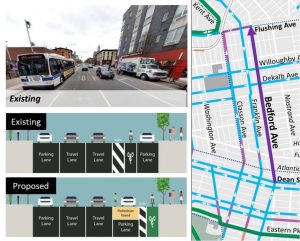
A portion of the Bedford Avenue redesign being implemented, starting this week. Credit: NYC DOT.
By Jean Brannum | jbrannum@queensledger.com
New York City Department of Transportation Commissioner Ydanis Rodriguez announced Sept 10 that construction would begin this week on a new protected bicycle lane and other major safety improvements planned for Bedford Avenue in Bedford-Stuyvesant.
Improvements include a 1.5-mile protected bike lane and the addition of pedestrian islands to reduce crossing distance. There will also be new loading zones to maintain curbside access for delivery vehicles.
The DOT noted that the City has seen a 15% decrease in crashes with injuries and a 21% decline in injuries after similar redesigns.
“The addition of a parking-protected bike lane on Bedford Avenue will create a critical cycling link in an area where bicycle ridership is booming, while making the road safer for everyone—whether you’re walking, biking, or traveling by car,” said NYC DOT Commissioner Ydanis Rodriguez.
Rodriguez mentioned that the decision came after outreach along the street.
The northern part of Bedford Ave between Dean St and Flushing Ave is known for speeding, and five pedestrian deaths since 2020.
“Biking along Bedford Avenue in Bed Stuy has been unsafe for too many years,” said Councilmember Lincoln Restler. “I’m elated that DOT has embraced a sustained campaign from community members and elected officials to install a protected bike lane on Bedford Avenue.”
At the same time, more people in the surrounding neighborhoods are cycling. Community Board 3 district is home to more than 4,000 Citi Bike annual members. In 2022, 494,000 trips began within the district’s boundaries.
During outreach over the past two years, the DOT identified and spoke with stakeholders along the corridor. The agency hosted several meetings, walkthroughs, and site visits to ensure that the Bedford Avenue project accommodates the street’s diverse needs.
DOT workers will begin removing the top road surface, a process called milling, of Bedford Avenue between Dean St and Lafayette Avenue this week. Streets typically remain milled for two to three weeks before being paved, a period in which utilities are strongly encouraged to do work that would otherwise require digging up the pavement. The DOT expects the entire redesign process along Bedford Avenue to be completed by the end of the year.
At more than 10 miles, Bedford Avenue is Brooklyn’s longest street, stretching from Sheepshead Bay to Williamsburg.


